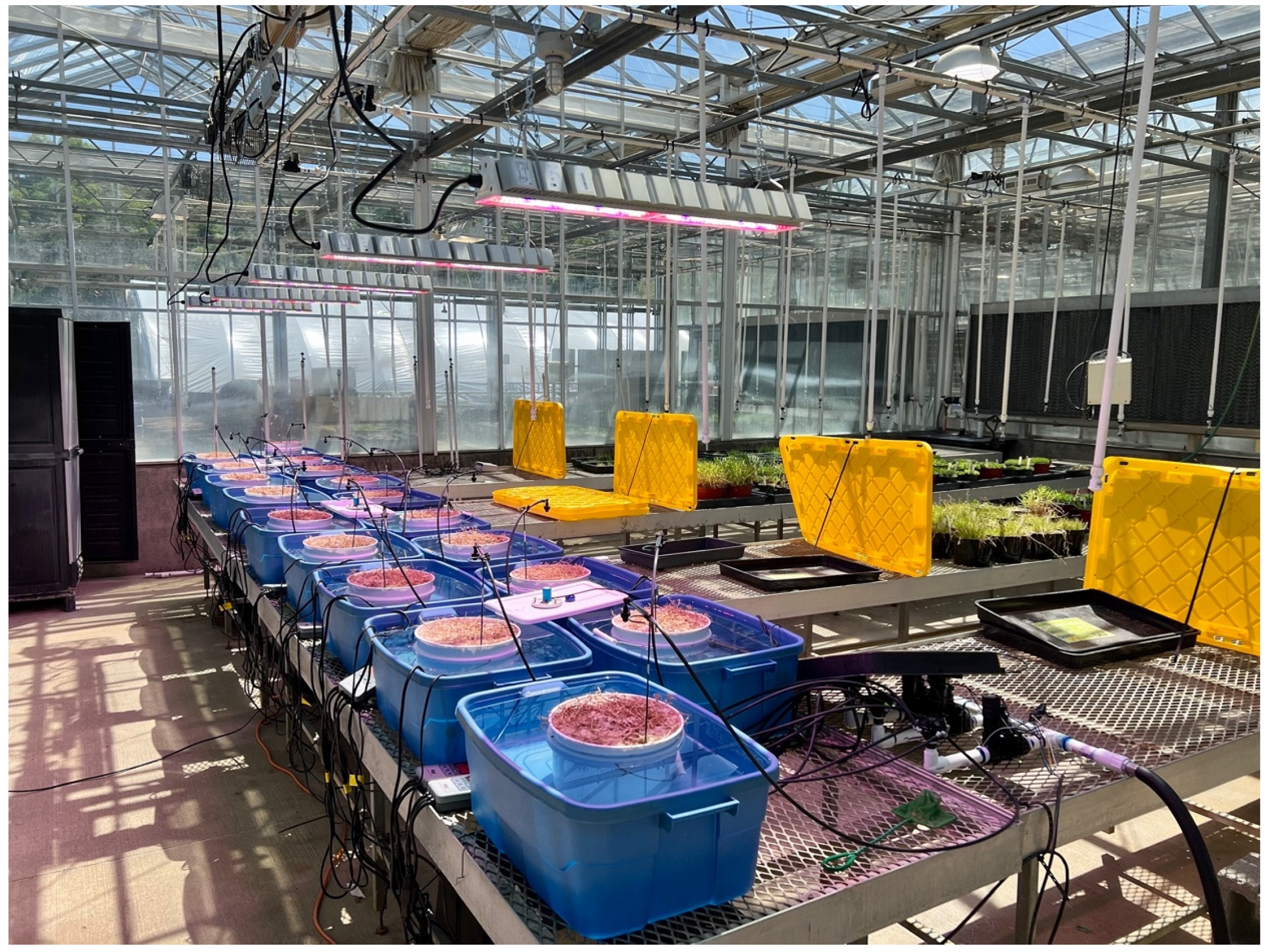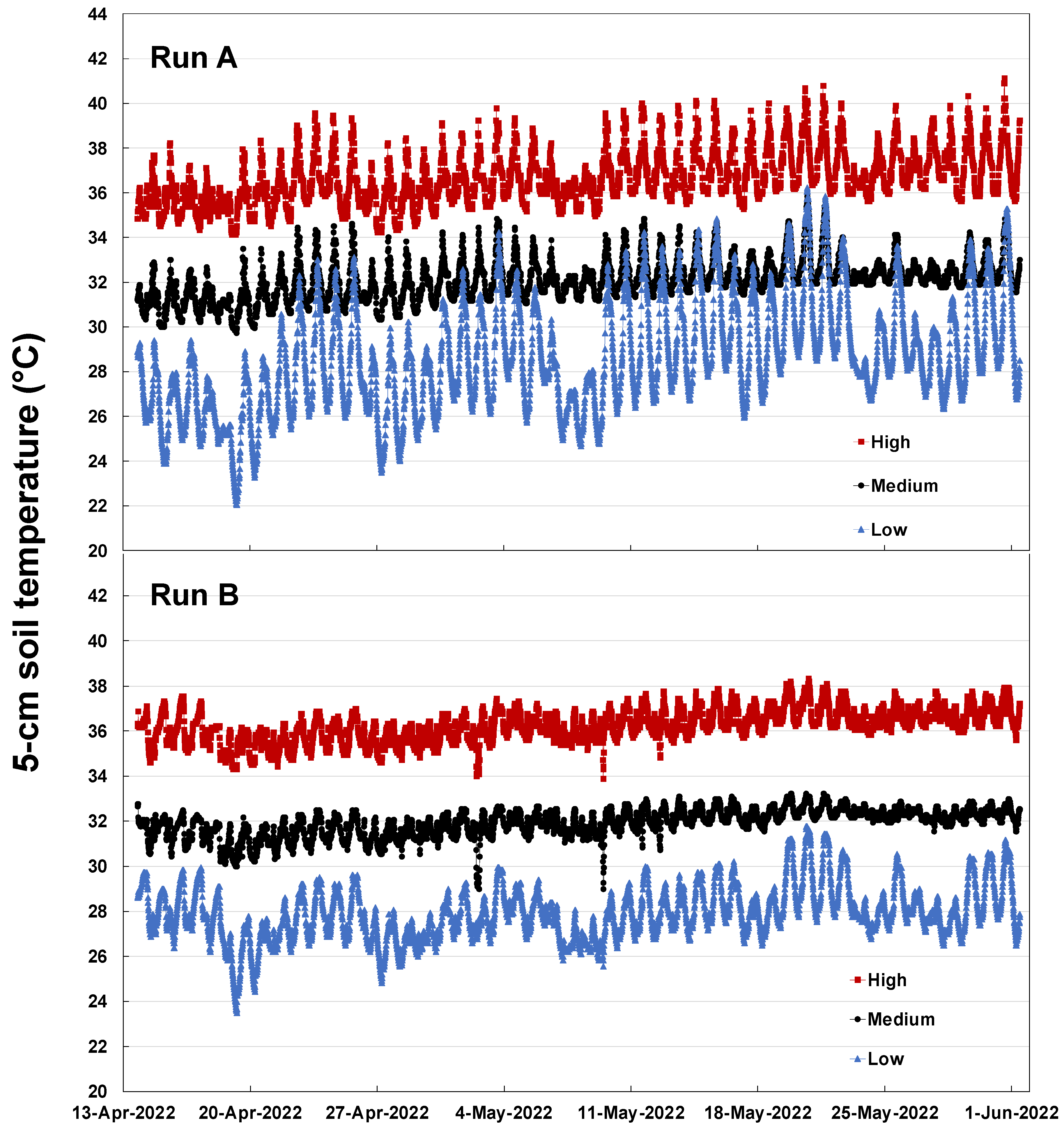Impact of Soil Temperature on Prizm Zoysiagrass Establishment from Sprigs
Abstract
1. Introduction
2. Materials and Methods
2.1. Research Site Management and Treatment Description
2.2. Data Collection and Statistical Analysis
3. Results and Discussion
4. Conclusions
Supplementary Materials
Author Contributions
Funding
Data Availability Statement
Acknowledgments
Conflicts of Interest
Abbreviations
| DAP | days after planting |
| VPD | vapor pressure deficit |
References
- Patton, A.J.; Schwartz, B.M.; Kenworthy, K.E. Zoysiagrass (Zoysia spp.) history, utilization, and improvement in the United States: A review. Crop Sci. 2017, 57, 37–72. [Google Scholar] [CrossRef]
- Brosnan, J.T.; Peake, J.B.; Schwartz, B.M. An examination of turfgrass species use on golf course putting greens. Crop Forage Turfgrass Manag. 2022, 8, e20160. [Google Scholar] [CrossRef]
- Engelke, M.C.; Colbaugh, P.F.; Reinert, J.A.; Marcum, K.B.; White, R.H.; Ruemmele, B.; Anderson, S.J. Registration of ‘Diamond’ zoysiagrass. Crop Sci. 2002, 42, 304–305. [Google Scholar] [CrossRef] [PubMed]
- Briscoe, K.; Miller, G.; Brinton, S.; Bowman, D.; Peacock, C. Evaluation of ‘Miniverde’ bermudagrass and ‘Diamond’ zoysiagrass putting green establishment using granular fertilizer applications. HortScience 2012, 47, 943–947. [Google Scholar] [CrossRef]
- Zhang, J.; Richardson, M.D.; Karcher, D.; McCalla, J.; Mai, J.; Luo, H. Dormant sprigging of bermudagrass and zoysiagrass. HortTechnology 2021, 31, 1–10. [Google Scholar] [CrossRef]
- Doguet, D.; Doguet, D.A.; Lehman, V.G. Zoysiagrass Plant Named ‘M60’. U.S. Patent USPP29143P3, 20 March 2018. [Google Scholar]
- Carr, T.Q.; Sorochan, J.C.; Brosnan, J.T.; Horvath, B.J. Effect of planting date and phosphorus rate on ‘Prizm’ zoysiagrass establishment from sprigs. In Proceedings of the ASA, CSSA, SSSA International Annual Meeting, Salt Lake City, UT, USA, 7–10 November 2021. [Google Scholar]
- Stiglbauer, J.B.; Liu, H.; McCarty, L.B.; Park, D.M.; Toler, J.E.; Kirk, K. ‘Diamond’ zoysiagrass putting green establishment affected by sprigging rates, nitrogen sources, and rates in the southern transition zone. HortScience 2009, 44, 1757–1761. [Google Scholar] [CrossRef]
- Carroll, M.J.; Dernoeden, P.H.; Krouse, J.M. Cultural methods to enhance zoysiagrass establishment: Herbicides give zoysiagrass the edge. Golf Course Manag. 1997, 63, 53–57. [Google Scholar]
- Richardson, M.D.; Boyd, J.W. Establishing Zoysia japonica from sprigs: Effects of topdressing and nitrogen fertility. HortScience 2001, 36, 377–379. [Google Scholar] [CrossRef]
- Johnson, C.M.; Thompson, W.R. Fall and winter seeding of lawns. Miss. Farm Rev. 1961, 4. [Google Scholar]
- Henry, J.M.; Tjosvold, S.; Gibeault, V.A. Zoysiagrass establishment. Calif. Turfgrass Cult. 1988, 38, 1–4. [Google Scholar]
- Patton, A.J.; Hardebeck, G.A.; Williams, D.W.; Reicher, Z.J. Establishment of bermudagrass and zoysiagrass by seed. Crop Sci. 2004, 44, 2160–2167. [Google Scholar] [CrossRef]
- Sladek, B.S.; Henry, G.M.; Auld, D.L. Effect of genotype, planting date, and spacing on zoysiagrass establishment from vegetative plugs. HortScience 2011, 46, 1194–1197. [Google Scholar] [CrossRef]
- Soil Temperature Maps. Available online: https://www.greencastonline.com/tools/soil-temperature (accessed on 12 September 2022).
- USGA. USGA Recommendations for a Method of Putting Green Construction. Available online: https://archive.lib.msu.edu/tic/usgamisc/monos/2018recommendationsmethodputtinggreen.pdf (accessed on 15 June 2022).
- Xu, Q.; Huang, B. Effects of differential air and soil temperature on carbohydrate metabolism in creeping bentgrass. Crop Sci. 2000, 40, 1368–1374. [Google Scholar] [CrossRef]
- Huang, B.; Liu, X.; Xu, Q. Supraoptimal soil temperatures induced oxidative stress in leaves of creeping bentgrass cultivars differing in heat tolerance. Crop Sci. 2001, 41, 430–435. [Google Scholar] [CrossRef]
- Richardson, M.D.; Karcher, D.E.; Purcell, L.C. Quantifying turfgrass cover using digital image analysis. Crop Sci. 2001, 41, 1884–1888. [Google Scholar] [CrossRef]
- Karcher, D.E.; Purcell, C.J.; Richardson, M.D.; Purcell, L.C.; Hignight, K.W. A new Java program to rapidly quantify several turfgrass parameters from digital image analysis. In Proceedings of the 2017 ASA, CSSA, and SSSA International Annual Meeting, San Antonio, TX, USA, 22–25 October 2017. [Google Scholar]
- Karcher, D.E.; Richardson, M.D. Digital image analysis in turfgrass research. In Turfgrass: Biology, Use, and Management; Stier, J., Horgan, B., Bonos, S., Eds.; Agronomy Monograph 56; ASA, CSSA, and SSSA: Madison, WI, USA, 2013; pp. 1133–1149. [Google Scholar]
- Ivory, D.A.; Whiteman, P.C. Effect of temperature on growth of five subtropical grasses. I. Effect of day and night temperature on growth and morphological development. Aust. J. Plant Physiol. 1978, 5, 131–148. [Google Scholar] [CrossRef]
- Sunoj, V.S.J.; Shroyer, K.J.; Jagadish, S.V.K.; Prasad, P.V.V. Diurnal temperature amplitude alters physiological and growth response of maize (Zea mays L.) during the vegetative stage. Environ. Exp. Bot. 2016, 130, 113–121. [Google Scholar] [CrossRef]
- Nishimoto, R.K.; McCarty, L.B. Fluctuating temperature and light influence seed germination of goosegrass (Eleusine indica). Weed Sci. 1997, 45, 426–429. [Google Scholar] [CrossRef]
- Earthstream Platform. Available online: mesur.io (accessed on 10 June 2022).
- Wherley, B.G.; Sinclair, T.R. Differential sensitivity of C3 and C4 turfgrass species to increasing atmospheric vapor pressure deficit. Environ. Exp. Bot. 2009, 67, 372–376. [Google Scholar] [CrossRef]
- LeBude, A.V.; Goldfarb, B.; Blazich, F.A.; Frampton, J.; Wise, F.C. Mist level influences vapor pressure deficit and gas exchange during rooting of juvenile stem cuttings of loblolly pine. HortScience 2005, 40, 1448–1456. [Google Scholar] [CrossRef]


| Source of Variation | Run A | Run B |
|---|---|---|
| P > F | ||
| Turfgrass coverage | ||
| Soil temperature | 0.16 | 0.08 |
| Days after planting (DAP) | <0.0001 | <0.0001 |
| DAP × Soil temperature | <0.0001 | 0.0006 |
| Soil Temperature (°C) | 7 DAP † | 14 DAP | 21 DAP | 28 DAP | 35 DAP | 44 DAP | 49 DAP |
|---|---|---|---|---|---|---|---|
| Turfgrass coverage (%) | |||||||
| Run A | |||||||
| High (36.6) | 2 | 6 | 12 | 21 | 48 b | 64 b | 70 b |
| Medium (32.1) | 0 | 3 | 14 | 36 | 68 a | 82 a | 88 a |
| Low (28.6) | 2 | 4 | 9 | 33 | 77 a | 93 a | 96 a |
| Run B | |||||||
| High (36.2) | 3 | 5 | 11 | 24 b | 55 b | 74 b | 87 |
| Medium (31.9) | 0 | 4 | 10 | 36 a | 75 a | 92 a | 96 |
| Low (27.9) | 1 | 2 | 4 | 18 b | 53 b | 78 b | 91 |
| Soil Temperature (°C) | Average Maximum | Average Minimum | Amplitude (Maximum–Minimum) |
|---|---|---|---|
| Run A | |||
| High (36.6) | 38.9 | 35.3 | 3.6 |
| Medium (32.1) | 33.7 | 31.2 | 2.5 |
| Low (28.6) | 31.7 | 26.2 | 5.5 |
| Run B | |||
| High (36.2) | 37.2 | 35.4 | 1.8 |
| Medium (31.9) | 32.6 | 31.2 | 1.4 |
| Low (27.9) | 29.3 | 26.6 | 2.7 |
Publisher’s Note: MDPI stays neutral with regard to jurisdictional claims in published maps and institutional affiliations. |
© 2022 by the authors. Licensee MDPI, Basel, Switzerland. This article is an open access article distributed under the terms and conditions of the Creative Commons Attribution (CC BY) license (https://creativecommons.org/licenses/by/4.0/).
Share and Cite
Carr, T.Q.; Sorochan, J.C.; Brosnan, J.T.; Horvath, B.J. Impact of Soil Temperature on Prizm Zoysiagrass Establishment from Sprigs. Agronomy 2022, 12, 2329. https://doi.org/10.3390/agronomy12102329
Carr TQ, Sorochan JC, Brosnan JT, Horvath BJ. Impact of Soil Temperature on Prizm Zoysiagrass Establishment from Sprigs. Agronomy. 2022; 12(10):2329. https://doi.org/10.3390/agronomy12102329
Chicago/Turabian StyleCarr, Tyler Q., John C. Sorochan, James T. Brosnan, and Brandon J. Horvath. 2022. "Impact of Soil Temperature on Prizm Zoysiagrass Establishment from Sprigs" Agronomy 12, no. 10: 2329. https://doi.org/10.3390/agronomy12102329
APA StyleCarr, T. Q., Sorochan, J. C., Brosnan, J. T., & Horvath, B. J. (2022). Impact of Soil Temperature on Prizm Zoysiagrass Establishment from Sprigs. Agronomy, 12(10), 2329. https://doi.org/10.3390/agronomy12102329






